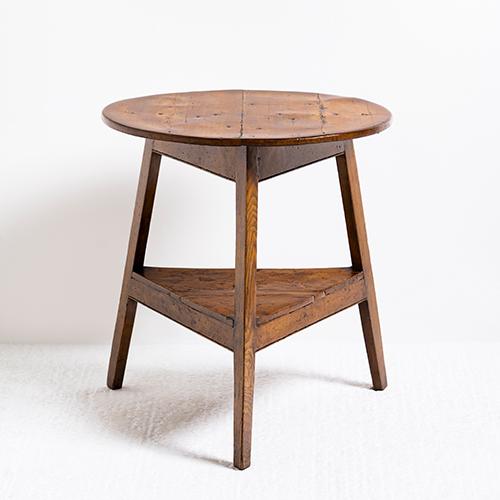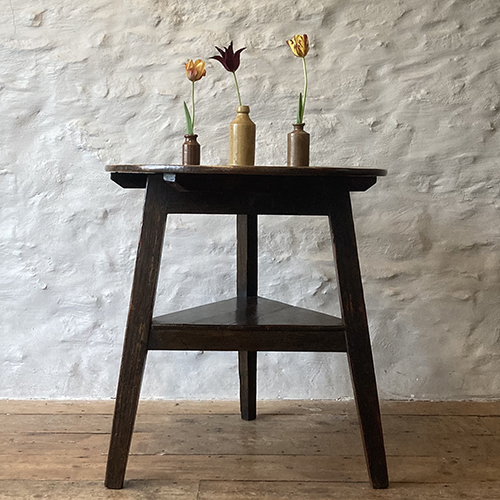

A corner stone of English vernacular country furnishings since the early 16th century, the cricket table is one Britain’s most popular and practical pieces of furniture.
Constructed in durable native English hardwoods, such as oak, elm, ash or sycamore, cricket tables are incredibly versatile and virtually indestructible. The classic table traditionally takes the form of a rounded top, standing on three splayed tripod legs, united by an under-tier shelf or stretcher.
Received wisdom suggests the three-legged design offered a perfect counter to the rough stone flags and uneven flooring of Elizabethan taverns and homes of modest means. The tables were certainly popular in inns and hostelries where their low shelves presented a place to rest a tankard, while the tabletop could be used for food or as an impromptu card table.
Their hardwearing stability is believed by many to be the derivation for the name cricket table, as the tripod design provided a sturdy surface for spectators watching cricket matches. By contrast, a four-legged table would be less likely to balance on rough ground or amid thick grass.
Another sporting theory for the nomenclature is that the table’s tripod design strongly resembles the three stumps of a wicket, with the tabletop serving for a set of bails. Whilst it is not beyond the bounds of reason to imagine a table being used as a makeshift wicket for an improvised cricket match, there is no historical evidence to support the idea. Moreover, there is an abundance of documentary evidence for the tables more mundane uses in pubs and domiciles, suggesting their link with the sport is fanciful at best.
 A third suggestion is that the term cricket is a colloquial evolution of the cracket or crackett stool, which is a similar form of vernacular furniture ubiquitous in the northeast of England. Thought to have originated in the mining towns of Northumberland, crackets are small four-legged stools which are said to have been used as back or head rests by miners working cramped, inaccessible seams.
A third suggestion is that the term cricket is a colloquial evolution of the cracket or crackett stool, which is a similar form of vernacular furniture ubiquitous in the northeast of England. Thought to have originated in the mining towns of Northumberland, crackets are small four-legged stools which are said to have been used as back or head rests by miners working cramped, inaccessible seams.
The simple, rustic stools soon arrived in the home where they were adapted as seating for small children or as convenient footrests. Due to the proliferation of mines in the region, it was not unusual to find multiple crackets in the home, and the diminutive stools were a common household feature in Durham and the northeast well into the 20th century.
Whichever theory you subscribe to, the cricket table remains an affordable, practical, and extremely versatile piece of furniture. Well-used and cherished through generations, most antique examples have absorbed a warm colour and rich patina, making them a simple but elegant addition to any contemporary domestic setting.
Click here to view a selection of tables currently available from BADA members.

